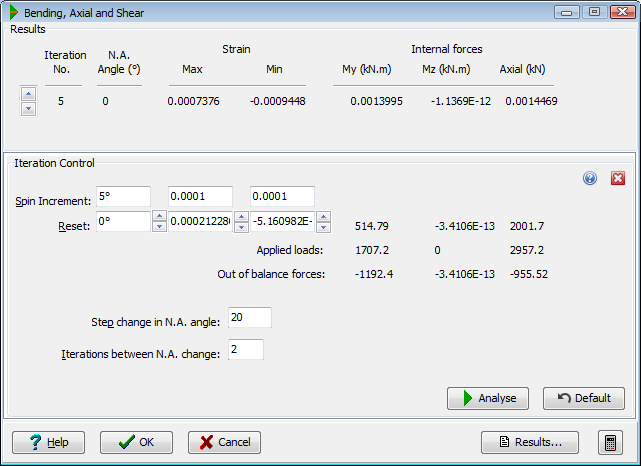Iteration Control
Description
This panel will be shown if an analysis has failed to converge to a solution. This may be for several reasons, for example:
- No solution is possible
- The tension strain has exceeded 10%
- The iteration tolerance is too tight
- The section being analysed is numerically unstable (which may be due to the inherent non-linearity of the material properties, or a feature of the cross section, for example).
Usually when this occurs the analysis can be forced to converge by modifying the starting values for the iteration process. Refer to the topic Controlling Iterations for further information. Click the Analyse button to restart the analysis or the Close button to return to the settings preceding the last iteration. The Default button will reset the N.A. step change and the number of iterations between N.A. change values, as well as resetting the starting strain plane.
The up down control in the results panel can be used to view the strain planes for previous iterations.
Form Graphic

Related Topics
Field Help
Reset N.A. Angle
Reset Strain - Max
Reset Strain - Min
The solution strain plane is defined by a Neutral Axis angle, and the strain at the two points on the section which are furthest from the NA in both directions (i.e. the maximum and minimum strains).
If the values selected by the application at the start of the iterations have failed to converge to a solution, new starting values may be entered in these 3 fields before restarting the iterative process.
As values are entered the equivalent internal forces, and the revised out-of-balance forces are displayed in the adjacent fields. (Note that using this facility it is theoretically possible to manually find the solution).
The table above displays the results of each iteration.
Step change in NA angle
Iterations between NA change
The solution algorithm varies the Neutral Axis angle after every 2 or 3 iterations, initially by 20 degrees until the out of balance y-momentz-moment changes sign, thereafter it interpolates.
For some sections that have failed to converge (e.g. sections whose Iyy) is much greater than Izz) a smaller value of initial change to the Neutral axis angle will facilitate convergence.
For some sections modifying the number of iterations before changing the NA angle will be effective in arriving at the solution. These fields enable those changes to be made.
